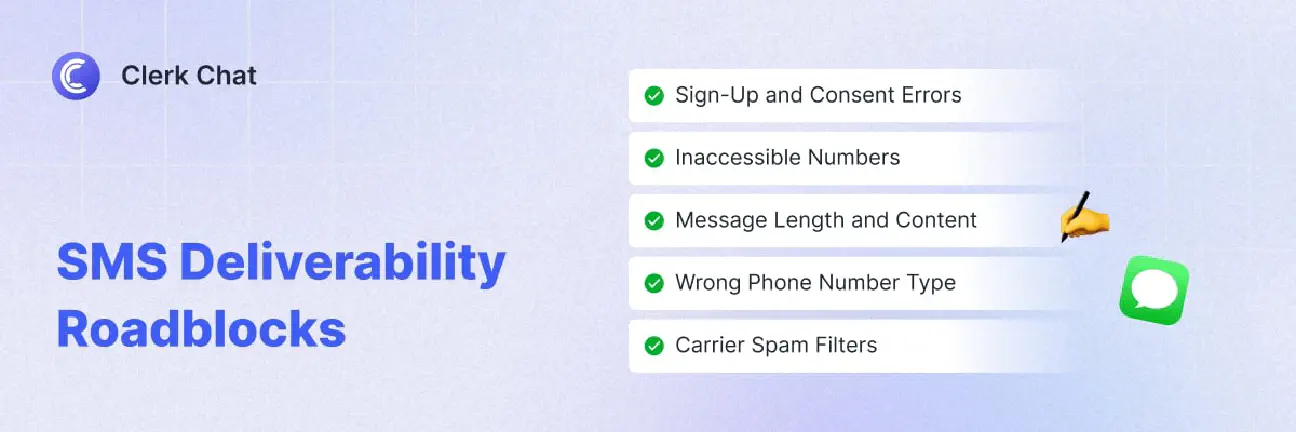SMS Deliverability: How to Improve your SMS Delivery Rate and Overcome Delivery Issues
By Team Clerk Chat
- Published: August 12, 2024
There are various factors that go into determining whether your SMS marketing and customer service strategies are effective - or not. But without a good SMS deliverability rate, you’ll never achieve the return on investment you might be hoping for.
Even if you have a healthy subscriber list, the ultimate software to help you implement mass text messaging campaigns, and a great approach to personalizing your notifications, those things won’t mean anything if your texts never reach your customers.
A strong SMS delivery rate shows you’re genuinely connecting with your target audience. The only problem? It can be harder to achieve than you’d think.
Here, we’ll introduce you to the top factors that affect your SMS message delivery rates and what you can do to improve your results.
What is SMS Delivery or Deliverability?
SMS delivery, or deliverability rate, is a measurement that examines the percentage of outgoing SMS and MMS messages that are received by your intended contact. Basically, it looks at how many of the messages you’re sending are reaching their targets.
Usually, companies examine this ratio in conjunction with their SMS bounce rate, which outlines how many of your customers are not receiving text messages from you when they should be.
The reality is that not all messages are guaranteed to reach their intended audience. Various factors can block your message during its journey, from carrier filters, to spam protection systems.
To achieve high SMS deliverability rates, companies need to do more than simply use the right technology. They need to ensure they’re following SMS compliance regulations, adhering to communications best practices, and constantly updating and optimizing their strategies.

Factors That Affect SMS Delivery Rate (and What You Can Do)
Ultimately, it’s almost impossible to achieve an SMS deliverability rate of 100%. Even if you do everything right, scheduled text messages can get lost in transit due to a range of technical issues. However, there are steps you can take to reduce certain deliverability issues.
Here are some of the top factors that influence SMS delivery rate and what you can do about them.
Delivery Issue 1: Sign-Up and Consent Errors
One of the most common reasons you’ll get the “failed to send message” notification when trying to contact a customer, is that they haven’t agreed to be contacted by you in the first place. Now that spam and phishing texts are so common, some device manufacturers allow customers to block all messages that come from “unrecognized” numbers on their phone.
If you haven’t requested permission to contact someone, and asked them to “whitelist” your number, then your messages could be automatically blocked.
The easiest way to address this issue is to obtain explicit consent to contact anyone on your communication list. This not only boosts your chances of actually reaching your customers, it also ensures you can adhere to TCPA and other regulatory guidelines.
Using a double opt-in process, where you ask customers to confirm they want to hear from you after they enter their details into a contact form or website can address this consent issue. It also tackles another problem: customers entering the wrong number into forms.
If a customer enters an incorrect number by mistake, then they won’t be able to respond to your double opt-in confirmation text, which means you can remove them from your contact list.
Delivery Issue 2: Inaccessible Numbers
We’ve already mentioned that your SMS deliverability rate can be affected by someone entering the wrong number into your registration form, but it isn’t just erroneous inputs that can get in the way.
Some customers may have placed their number on the “Do Not Call” list, which may prevent you from sending messages to that customer. Even transactional SMS messages could be accidentally blocked. It’s worth double-checking the Do Not Call registry regularly, just in case.
Another reason a number may be “inaccessible” is if your customer has specifically blocked your phone number on their phone. When this happens, the only option is to ask your customer to “whitelist” your number again, so they can receive your text.
To reduce your risk of issues make sure you review your contact list regularly, and check for any number inaccuracies, DNC problems, or opt-out requests.
Delivery Issue 3: Your Message is Too Long or Inappropriate
Whether you’re investing in conversational texting strategies or an automated texting campaign, it’s important to understand the limitations around what you can send to your customers.
On a basic level, your automated text message solution will likely restrict your messages to 160 characters per text. Anything longer than this will be split into multiple messages, which can cause technical faults and SMS deliverability issues.
There are other potential restrictions that might affect your results too. For instance, if you want to adhere to the TCPA compliance checklist, you’ll need to ensure you’re not sending “soliciting” (marketing) content between certain hours of the day.
Plus, many carriers in the SMS landscape will automatically “flag” text messages that include certain terms they’ve deemed “spammy”, which can harm your deliverability rates again.
The best way to address this issue is to use clear templates to ensure all of your text messages are short, concise, and adhere to industry standards. Plus, make sure you’re scheduling your messages to deliver at the right times.
Delivery Issue 4: You’re Using the Wrong Type of Phone Number
There are various types of phone numbers available to brands in all industries when they begin to use text messaging for marketing purposes. These include dedicated 5 and 6-digit short codes, toll-free numbers, and application to person 10DLC numbers.
For smaller businesses, toll-free numbers might be fine. However, for a larger organization, a 10DLC number can give you a more budget-friendly solution, help you bypass common spam filters, and significantly improve your SMS deliverability rates.
10DLC numbers can use dedicated channels for message delivery, which are often recognized as legitimate by carriers, reducing delivery failure rates.
A leading messaging company like Clerk Chat can help you complete the 10DLC registration process, ensuring you have the right number in place for your text messaging campaigns. We can even help power your Microsoft Teams or Zoom SMS campaign.
Delivery Issue 5: Carrier Spam Filters
Finally, one of the most common issues that affects SMS deliverability rates stems from carriers implementing their own spam filters. Most of the top carriers will use filters to prevent subscribers from receiving any spammy or fraudulent messages.
Even if your messages are safe and legitimate, there’s a risk that you could still be classified as spam, particularly if you’re using AI text messages that use specific terms, or you’re sending large numbers of identical text messages to numerous customers at once.
Ultimately, the best strategy to avoid this problem is to read up on compliance guidelines, ranging from 10DLC regulation mandates to TCPA and beyond. Consider using different sender IDs for campaigns if you notice your delivery rate dropping, and test them with various Zoom phone texting and standard SMS campaigns.
It’s also worth making sure your templates are designed with regulatory compliance in mind. Including opt-out instructions in your text messages templates, and eliminating any spammy terms or unnecessary elements can help you to bypass spam filters.
Use Clerk Chat for an Excellent SMS Delivery Service
Ultimately, mastering SMS delivery can be more difficult than it seems.
There’s more to launching a successful messaging strategy than choosing a messaging software and hitting send on a large volume of mass texts. You need to ensure you’re adhering to compliance guidelines, sending protected texts to the right customers, and using the right number.
Fortunately, Clerk Chat makes boosting your SMS deliverability rate a breeze. Not only do we offer an easy-to-use tool for leveraging SMS for Microsoft Teams and other platforms, but our solution helps companies to customize and optimize their automated campaigns for the best results.
With high-quality templates, end-to-end security, and powerful analytics, you’ll be able to upgrade your text messaging strategy and preserve your brand’s reputation, while building stronger relationships with your target audience.
We even help companies improve their compliance with industry regulations, whether you’re applying for 10DLC registration or using a messages archiving solution to keep track of essential data, our team can help you implement a successful strategy.
Contact Clerk Chat today to learn more about how hour technology can improve your SMS deliverability rates and boost your return on investment.
In this article:
Ready to use your business number for text messaging?
Thousands of businesses are already experiencing the power of conversational messaging through SMS. Join us. Free trial and paid tiers available.
Get Started#Subscribe
Get product updates in your inbox
Tutorials, features, and Clerk Chat news delivered straight to you.




